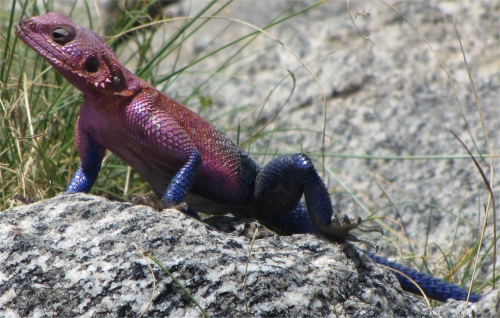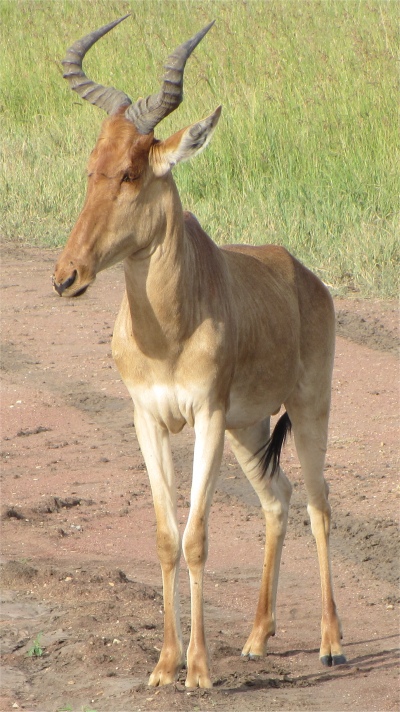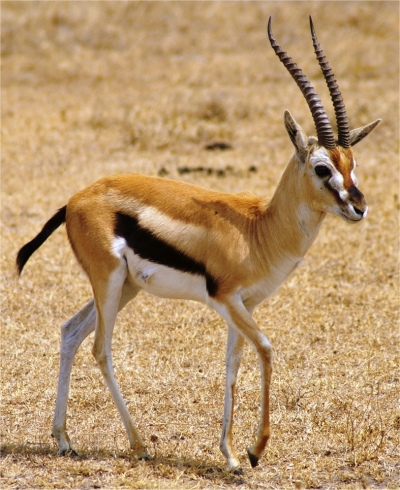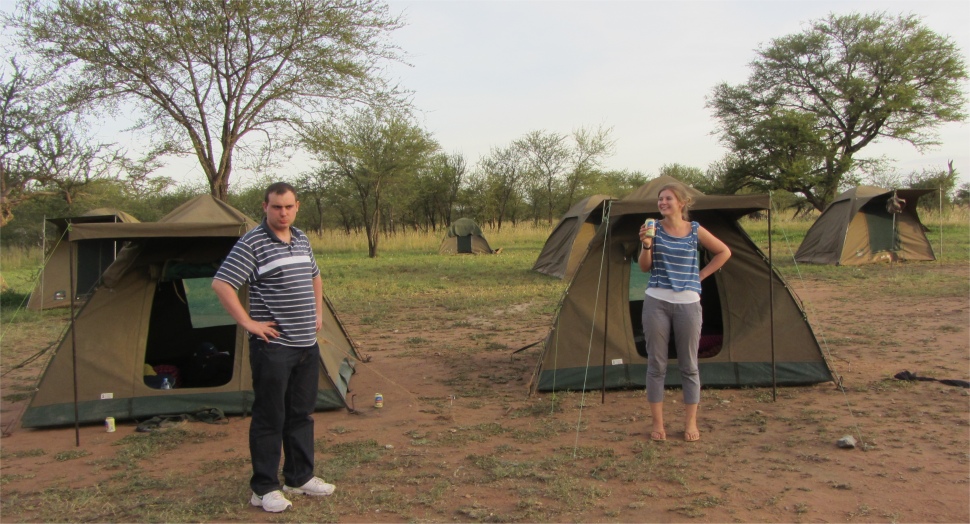
Agama Lizard
|
The huge expansive sea of grasslands, dotted with clouds of dust from the 4x4s speeding across it, stretched monotonously below the azure blue sky. Then, as a welcome relief, a rocky island appeared, Naabi Hill. Such outcrops, resembling Devonshire Tors, are called kopje.
Kopje is a Dutch word meaning small hill. The Serengeti kopjes consist of old granite rock, broken and worn by constant expansion and contraction due to abrupt temperature changes. Like oceanic islands, they have their own range of vegetation and wildlife. Naabi Hill, marks the major gate of the Serengeti, commanding the most beautiful acacia and short-grass savannah, the plains sweeping away on every hand as if to challenge the concept of the horizon. We stopped off for a picnic lunch on this oasis for travellers, a haven for many groups from around the world, all picnicking, and all united by their common desire to explore this Serengeti animal kingdom in its natural state.

Leopard in Tree - Clever Camouflage
|
The ever hopeful Superb Starlings hopped from table to table scooping up crumbs. Large Marabou Storks slowly and earnestly marched about with a pompous air about them, searching for larger crumbs. Seeing them close up, they did seem rather intimidating.
We climbed up to the highest point on the kopje for a photo session, disturbing an Agama Lizard, a charming wee fellow in his blue/pink uniform on the way. From the summit we were afforded a splendid vista, adding a third dimension to the monotonous two dimensional world we have travelled through getting here.
Leaving Naabi Hill behind us, we soon parted from the main trail and found ourselves totally off the beaten track, though Kepha seemed to have an inbuilt navigational system inside his brain through which he knew exactly where we were. The Serengeti landscape is covered in a lacework of dirt tracks, all invisible behind the long grass until we were on top of them. We twisted and turned along these tracks for miles and miles, targeting kopjes where we hoped to find lions -
simbas. Kepha informed us that each pride of lions would normally patrol 125 square kilometres. Other 4x4s could be spotted across the plains, also searching for wildlife.

Two Ton Bull Just Before He Charged Dan
|
The terrain was now changing to savannah, featuring longer grasses and acacia trees. Trees no longer grew in bows or cupolas, but had horizontal layers of light, delicate foliage. Our search seemed to be fruitless, only the odd group of elephants and giraffes were spotted. Then in the distance we saw a group of 4x4s parked up, a sure sign that something had been spotted. Kepha soon homed in on them, and we settled down to watch a leopard lying 6m up a tree, oblivious to the world, a marvellous sight.
A short while later we came across a group of elephants: a mother with two babies on one side of the track, the two ton bull on the other side. He was swinging a front leg back and forth to cut the grass with his rough thick nails, and swiftly wrapping it up with a curling movement of his trunk, and depositing it inside his mouth. This heavy, wise, majestic bearer of the ivory, deep in his own thought, wanted to be left to himself. Dan was taking a photo of the bull as he was walking by, about 4m away from us. The bull kept a wary eye on him, and then without warning, the big fellow suddenly turned around and lunged as if to charge. The effect this had on Dan was amazing, he immediately shot down into his seat, struck by terror. Sally also suffered a minor panic attack. Kepha and Erasto burst into fits of laughter. The bull turned away and carried on walking, no doubt tittering away to himself.
We had no more encounters along the way, and soon we were parked up at one of the Serengeti campsites. This was real camping - we had to erect our own tents, and I cleverly managed to take a chunk out of one of my fingers in the process. Amenities consisted of a couple of stand-up cubicles for the gents, and I guess the same for the ladies, and just one shower for the whole campsite. There was a 1-year old communal dining area, and a communal kitchen where Erasto prepared his wonders.

Haartebeest
|
We dined at dusk. Darkness was gathering fast as the warm red landscape sank into a deep purple gloom. The loud chattering of birds heralded the approaching silence of the night. Rats scurried along the dining hall walls and beneath our tables. The lighting in the dining area was dismal, just two LED bulbs. Kepha explained that the site was run from solar power and batteries. The water was delivered by water trucks.

Thomson's Gazelle
|
He advised us that we would hear lions through the night, usually just emitting a low grunt as they marked out their territory. Sally had got used to that in Kenya. Kepha also mentioned that hyenas often entered the campsite during the night scavenging for food. Hmmm ....... a bit disconcerting that the camp was in the middle of the Serengeti, and there was no fence around the campsite to keep the wild animal out. There was a lot of black humour circulating about the chances of occupants of tents pitched on the extremity of the site. In case you are wondering that the lack of fences is just a wind up, I can assure you that it is perfectly true. The premise in the Serengeti is that the whole park is for the benefit of the wildlife, and they should not be constrained from entering any area in which they wish to enter; hence no fences. The system must work otherwise the practice would not be permitted.
At this point Kepha told us the story of one of his clients who had been camping at the Havennature Safari Camp. The German chap was a fanatical jogger, and insisted on doing his usual distance down the trail leading up to the camp. Kepha advised him not to, but the bloke was adamant that he would shift quickly along the route, and would be back before any wildlife noticed him. He set off, but reappeared 15 minutes later at a hell of a pace and totally whacked out. He had come across a lion. Then there was the couple he had been guiding, who split up en route, and insisted on carrying on with the safari in different vehicles, and staying at different campsites. They cancelled the extension to their holiday in Zanzibar, and had insisted on being driven to different airports for their return back to the U.K. Crikey, some people live complicated lives.
During the course of the evening I got chatting to a middle-aged chap who had a strong American accent. I was amazed to find he hailed from Germany, but he admitted he had worked in the States for a period. He had tagged onto a group of three younger folk, who I gather he could do without, but it helped share the costs.
I also fell into conversation with a couple who I had first encountered at the entrance to the Ngorongoro Conservation Area; we seemed to bump into people time and time again. The chap was sipping coffee, and the lady was busying herself grinding coffee beans. She explained they loved decent coffee, and she was grinding Ethiopian coffee beans. It transpired that the couple hailed from the Vancouver area, and dealt in coffee, importing and distributing African coffee. They had been to a coffee conference in Lampala, Uganda, and were now enjoying a three day safari before spending some time in Zanzibar.
We settled down for the night as a milky full moon turned the landscape silver. Sadly thin cloud cover prevented a decent view of the heavens.

Our Tents in the Serengeti Campsite Where Animals Are Free to Roam
|

